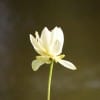 By Jim Stevenson,
By Jim Stevenson,
First, I’m glad for those of you who got to see the immature Groove-billed Ani that was in my yard last week. It has left, but they show up somewhere each year around the end of September. This poor female, marooned away from her parents, will surely be known in future circles as “Little Orphaned Ani.”
Second, my good friend Allen Hardee is having a “Big Sit” Saturday at his house, where they will be counting birds all day from his deck, overlooking Laffite’s Cove. You can come for any part of it. His e-mail is [email protected] and you can e-mail him for any further information. He’s a really nice guy. He lives at 13440 Jibstay Court, on the northwest corner of LCNP, in a light blue house. Just turn right immediately after Laffite’s Cove and it’s right there on the right.
Third, if anyone still wants to order calendars or whatever to support the GOS, please consider doing it now. The information is attached. ALSO, PLEASE SEND A CHECK THIS WEEKEND IF CONVENIENT, so I can concentrate more time on the Galveston bird book.
Fourth, we have our last field trips this weekend in the heart of the fall migration, with an all-day trip on Saturday ($50) and a Sunday morning on the West End for $25. Contact me asap if you’re interested.
Now, every month or so I send out a gallery on non-bird critters, and here it is. Have fun.
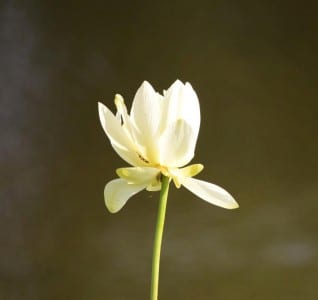
Over twenty years ago, when teaching gifted biology to the greatest people on Earth, I made up a chapter test on botany and needed one more question to fill out the test items. It had been my usual “bear” of a test, making kids actually think, and not just regurgitate stuff they’d memorized in their short-term memory. So I thought, what’s a really easy question? I know, “What is the reproductive organ of an angiosperm called?” It was too easy. Not one of my little Einsteins got it, even though the average score on the test was no doubt in the upper 80s. But I probably had not actually “said” the word in class. So, what was the answer? A flower. (A rose by any other name…)
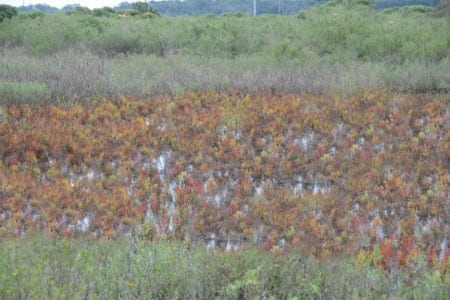
Whew, two plants in a row! Some of the salt marsh plants like Batis (sp?) and Salicornia lose chlorophyll in fall and other pigments then give off colors like red, purple and gold. This is an entire patch of these halophytes and the color is getting exciting. Halophytes live in (at least) 5% salt (open sea water is ca. 33% salt), and some plants can stand much more than 5%. However, there won’t be much flowering, or even growth, as the vast majority of the sugar made goes to pumping the salt out of their roots. The good news is, the salt acts as a limiting factor for other plants, so all they need to do is “survive” there, as competition becomes moot. I used to call this the Eskimo existence.
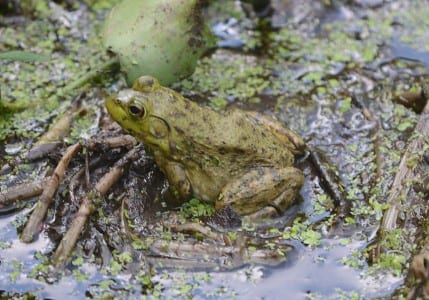
Bullfrogs are one of several species of North American frogs with neither warts nor suction cups on the toes. However, some have varying amounts of webbing, though this Bullfrog won’t have as much as, say, the closely-related Pig Frog. This species mostly lives along shorelines, but in Texas, west of the range of the aquatic Pig Frog, they will spend much more time in the water. I find the entire study of animals’ niches and interand intraspecies competition to be fascinating.
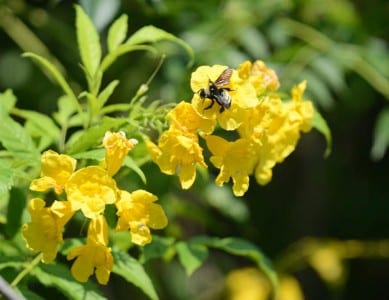
One of the most important relationships in all of nature involves the mutualism that exists between bees (Hymenoptera) and flowers (angiosperms). As you know, bees harvest nectar off the flowers and use it to make food. However, as they fumble around on the flowers, they wind up cross-pollinating f lowers of the same species, which really helps, since flowers can’t go spend the night together. If memory serves, this relationship took off in the late Mesozoic, and was primarily responsible for the explosion of flowering plants and pollinating insects on Earth. Vernon?
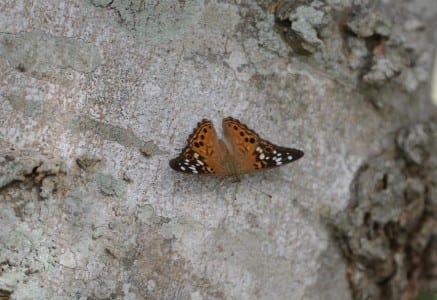
Many butterflies and moths are also pollinators, and quite a bit more friendly than some of the bees. Many (like Monarchs) have aposematic coloration, telling potential predators that they have a noxious taste in their wings. Others, like a Viceroy, mimic the Monarch and receive protection from that similarity. This guy above may do the same, although I am not sure of the species. Curiously, some animals instinctively “know” that Monarchs are nasty, but others (like Blue Jays) must learn it, p robably never forgetting it.
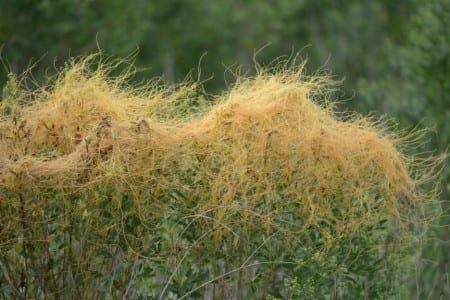
This interesting plant is called dodder, although many locals call it spaghetti grass. It has no chlorophyll and doesn’t photosynthesize. It is often found growing near the coast, and gives plants like this Baccharis an interesting top. It’s a very simple organism, with no leaf, stem or root, and it doesn’t photosynthesize. As one student said so many years ago, it lives on botanical welfare.
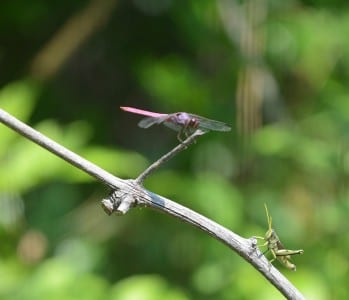
About half the species of animals in the World are insects, which is just one class of one phylum of animals. There are over a million species of insects on Earth and they are as diverse as any group of animals anywhere. Look at the structure of the carnivorous (well, insectivorous) dragonfly compared to the nearby vegetarian grasshopper. This is called disparity, where two creatures are structured so differently. So the phylum of Arthropoda has both diversity as well as disparity.
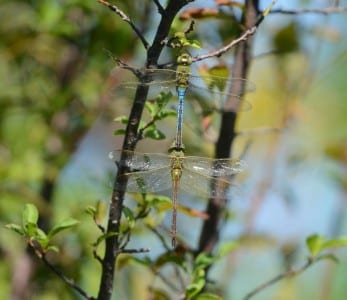
Sexual dimorphism is not just found in birds, and actually, is far more pronounced in many arthropods. These dragonflies (darners?) are more than friends, and huge numbers of insects lay eggs in fall that hatch out the following spring. They are far more valuable as mosquito eaters than the famous Purple Martins, and a lot of other birds.
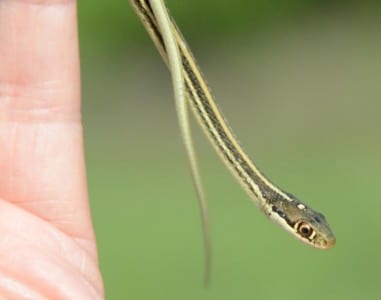
This is the Gulf-coast Ribbon Snake, a slender reptile of moist areas with small frogs. They are not poisonous, and if one were to bite you, it is doubtful you could feel it. You can tell it’s not a pit viper by noticing the round pupils that all our nonpoisonous snakes have. The only snake in North America with round pupils with a poisonous bite is the unmistakable Coral Snake.
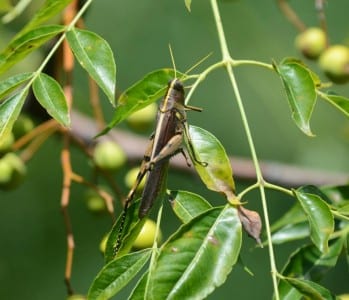
Grasshoppers have some amazing camouflage, and some come closely mimicking their surroundings. They are eaten by a lot of animals and for defense, aside form their colors, you can see the long legs with which they jump. Another defense is their wings, which lie underneath the long, brown covering, attached to the thorax. And last, many species like these have spines and such on their legs to discourage predators. Maybe this is why we have so many grasshoppers!
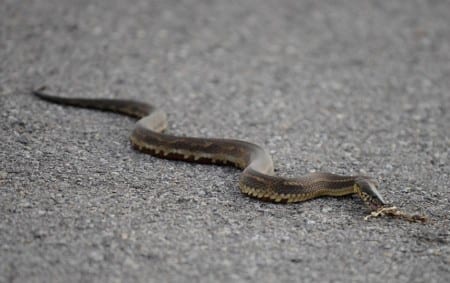
This is pretty amazing. It is only the second time I have ever seen a snake eating an animal killed on the road. The unidentifiable remains of a toad (?) is little more than creamed mush, yet the Gulf Salt Marsh Snake – normally which kills and eats small fish – is scraping it up off the road for din din. This is a very abundant, harmless snake of the needlerush and cordgrass, not uncommon right here on Galveston’s West End.
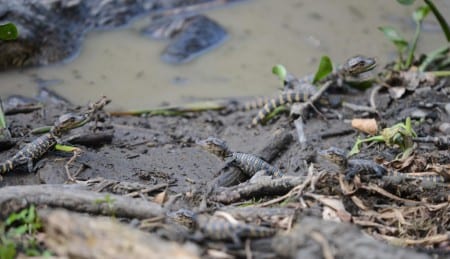
In fall, is places such as Brazos Bend State Park, it is not uncommon to find mother gators with clutches of babies. These are well less than a foot long and most reptiles are more brightly colored than their parents. As opposed to most human kids who *think* they are brighter…With as inoffensive as gators are, this would be a time *not* to disturb American Alligators, as they are one of the few reptiles who protect their offspring. Certain of the tropical vipers do as well."
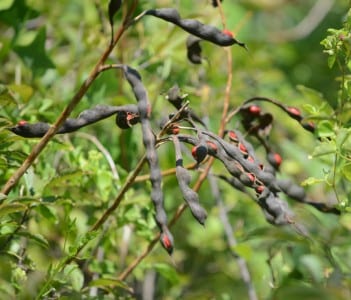
I know about as much about these red beauties as I do about certain of the insects, but I am quite sure what Red-eyed Vireos think of them. One bird kept returning every few minutes and snatching one out of the encasing. Birds are obviously responsible through seed dispersal for various plants expending their ranges hundreds of miles, as this vireo probably didn’t poop this material in North America.
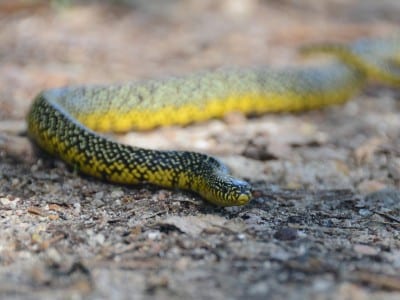
One of our most beautiful creatures is the Speckled Kingsnake, a harmless, salt n pepper reptile that eats poisonous snakes as a simple matter of course. They are immune to the venom of our native vipers, and they kill all their prey by constriction. Kingsnakes rarely bite people, although they may release musk and hiss a bit. This snake has gone from quite common when I first arrived 18 years ago to quite rare, and I had not seen one for several years until this fella laid out on my patio. It is extremely upsetting to me – and I hope to many of you – when entire groups of creatures virtually disappear in mere years at the hands of our species. I could probably name three times as many snakes which have been extirpated in my 18 years here than species which are still seen. This beauty is almost sure to follow.
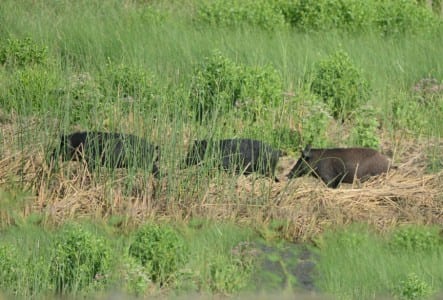
One of the many introductions that have backfired was the release of Russian Boar into our native lands. Now we have to pay gobs of taxpayer dollars to eradicate these beasts before they turn our parks and refuges into wastelands. Of course, nobody can enjoy the refuges right now anyway, so Martians may as well camp there and drink at Mars bars.
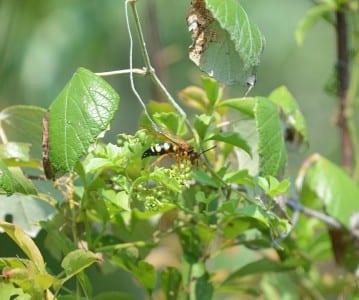
One of the very cool animals is the spider-killer. I don’t know the species (if there is more to the name) but these intentionally fly into spider webs, then stink and kill Charlotte when she runs up to her supposed prey. There are so many intricate and interesting relationships in the arthropod world, with more species than any scientist could ever know. BTW, good luck finding any “grape” vines in my yard now, as they have joined the dodo bird. They were choking the tops of several of my trees.
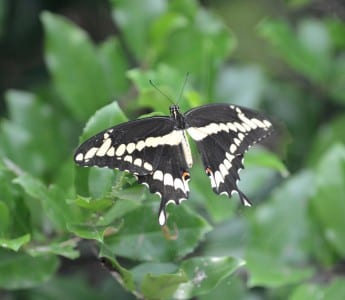
I believe this is a Giant Swallowtail, but I am *sure* it’s a beautiful butterfly that has hung out in my yard with its friends for a few weeks now. The metamorphosis of these gentle creatures is one of the great stories in nature, the tadpole-like emergence into frogdom. It almost defies the imagination that an animal like a caterpillar could undergo that much change and emerge as this magnificent insect. It shows there’s hope for us!

 Posted in
Posted in 























